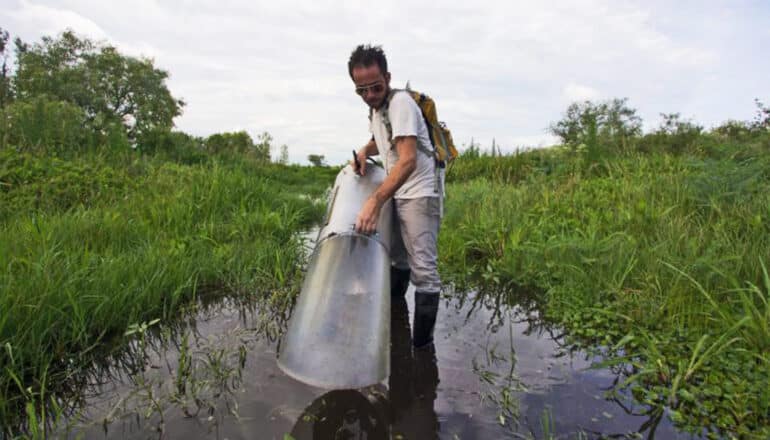
Another new mosquito species has made its way across the tropics into Florida, researchers report.
The findings concern scientists because of the rate of new mosquitoes arriving in the state, the potential for them to transmit diseases, and because there has not been enough research on the species.
The mosquito, known only by its scientific name, Culex lactator, was first discovered in Miami-Dade County in 2018 while researchers hunted for other nonnative mosquitoes. Since then, thriving populations have been recorded in Miami-Dade, Collier, and Lee counties.
“There are about 90 mosquito species living in Florida, and that list is growing as new mosquito species are introduced to the state from elsewhere in the world,” says Lawrence Reeves, an assistant professor and mosquito biologist at the University of Florida Institute of Food and Agricultural Sciences (UF/IFAS) and lead author of the study in the Journal of Medical Entomology.
Mosquitoes are among the most studied insects because they can transmit diseases. However, there are large gaps of knowledge, Reeves says.
“That’s particularly true for species from the tropical forests, where mosquitoes are diverse and understudied,” he says. “Introductions of new mosquito species like this are concerning because many of our greatest mosquito-related challenges are the result of nonnative mosquitoes, and in a case like this, it’s difficult to anticipate what to expect when we know so little about a mosquito species.”
Globally, there are more than 3,600 types of mosquitoes. When a novel mosquito is found in Florida, it could be any of these species. Reeves and his team used DNA analysis and other tools to not only discover they had found another mosquito species, but to identify it as Culex lactator.
Culex lactator is found in Central America and northern South America and is a member of the Culex group of mosquitoes. This group includes important species that transmit the West Nile and St. Louis encephalitis viruses, but it is unclear whether Culex lactator will contribute to the transmission of these viruses in Florida.
Every year, Florida faces challenges from mosquito-transmitted diseases like West Nile virus, eastern equine encephalitis virus, dengue virus, chikungunya virus, and others, Reeves says.
“It’s too early to know whether Culex lactator will exacerbate these challenges, but the implications are often difficult to predict because not all mosquito species are equally capable of transmitting a particular virus or other pathogen,” says Reeves. Each mosquito-borne virus is transmitted by only certain mosquito species, he says.
“We need to be vigilant for introductions of new mosquito species because each introduction comes with the possibility that the introduced species will facilitate the transmission of a mosquito-transmitted disease,” he says.
Researchers collected the initial specimens of Culex lactator in 2018 from rural sites in southern Miami-Dade County, south of Florida City, followed by additional adult and immature specimens collected through 2022 in the same locations. Each set of mosquitoes were collected from traps set by associate professor Nathan Burkett-Cadena, doctoral student Kristin Sloyer, and Reeves while looking for other recently introduced mosquitoes.
In 2022, scientists with the Collier Mosquito Control District and Lee County Mosquito Control District found Culex lactator in their counties, indicating that Culex lactator has likely spread from its initial point of introduction.
Currently, Culex lactator is known to live in Collier County—south and west of Naples—Lee County, west of Fort Myers, and in the Homestead area of Miami-Dade County, though it may have also spread elsewhere in the state, says Reeves.
“Culex lactator is physically similar to mosquito species already known from Florida. It looks like other more common mosquito species,” says Reeves. “Because of that similarity, the presence of Culex lactator in an area can be easy to miss.”
Reeves and his team stress it’s important to monitor for Culex lactator as it is likely to spread within the state into areas that are environmentally suitable.
Florida’s proximity to the tropics and climate conditions make it ideal for nonnative mosquitoes. Scientists are concerned about the rate and frequency of novel species establishing in Florida. As many as 17 nonnative mosquito species are established in the state.
Researchers stress that the detections of nonnative mosquito species are increasingly frequent, with 11 of 17 nonnative species first reported in the past two decades, and six of these 17 detected in only the past five years, says Reeves.
The mosquitoes Aedes aegypti, Aedes albopictus, and Culex quinquefasciatus—among the most important disease vectors in the United States—like Culex lactator, are nonnative species, introduced from the tropics.
“Climate change may improve the chances of tropical mosquito species becoming established once they make it to Florida if the state becomes warmer,” adds Reeves. “Increasing storm frequency and intensity could also blow in more mosquitoes and other species from the Caribbean, Central America, and elsewhere.”
Source: University of Florida
The post New mosquito species moves into Florida appeared first on Futurity.
from Futurity https://ift.tt/v9MnIRl
No comments:
Post a Comment